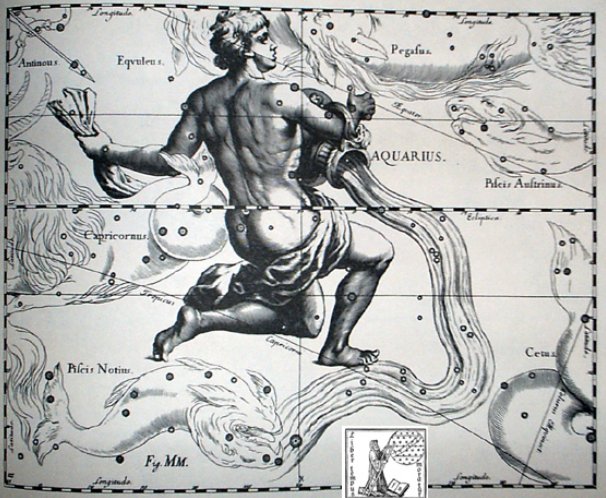3. Hevelius has, as usual with him, drawn his figure from a viewpoint outside the sky globe:
Instead of the Nilometer his person has a piece of cloth (not unfolded) in his left hand. Considering the position of Aquarius we can deduce it ought to be a precursor of the Black Cloth. Beyond Venus as Morning Star there follows a long period when she is unvisible:
Considering the fact that we have been able to imagine 8 dark nights preceding the 263 days from λ Orionis to λ Aquarii - instead of 8 such nights preceding 236 days as the Maya arranged it - we can expect a 50 glyph long sequence corresponding to a 'Black Cloth' period from Gb2-28:
λ Aquarii is balancing between 'March 2 and 'March 3. From Ga1-19 to Gb2-28 there are 264 glyphs.
Manu rere in Gb4-6 indeed could illustrate the phenomenon of evening star (in front and below) following morning star (at the back and above). However, from hipu at left (in Gb2-27) to hipu in front (Gb4-17) there are 65 days.
248 = 8 * 31 and 65 = 5 * 13. λ Aquarii is at glyph 284 which seems to allude to 584 (= 284 + 300). By shifting the order 284 becomes 248. 263 + 65 = 328 = 200π (Venus as Morning Star). 248 + 8 = 256 = 8 * 32 (Venus as Evening Star). Hipu in front (Gb4-17) - a Friday - is at glyph 348 which seems to allude to 248. The Urn could correspond to the beginning of a 'Black Cloth' season for Sun, in G stretching for 5 * 13 = 65 nights:
Counting from Antares (186) up to and including hipu in Ga4-17 there are 263 days. In the Arabic manzil system these 65 days seem also to be there, because 290 can be associated with 10 times the dark night of Moon. The corresponding dark cloth day of Sun surely must be winter solstice, 10 * 13 days later. 126 (= 2 * 63, alluding to 263) is 'May 6, the night when Algol and Misam were rising heliacally together:
A difference between the G text and the Arabic system could be the beginning. The manzil system starts with Sheratan 1 immediately after the heliacal rising of the Pleiades (in day 136 of the Gregorian calendar) whereas the G text may have its beginning 10 days earlier (at 3h = 46 days after equinox). |









